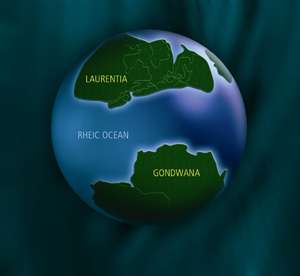Scientists reveal secrets of ancient ocean in new book

Call it the ocean that time forgot. About 400 million years ago, the Rheic Ocean played a big role in Earth’s history. When this massive body of water closed, the Appalachians were lifted to Himalayan heights and the planet’s continents slammed together to form the supercontinent of Pangaea. Dinosaurs and early mammals evolved to traverse the large swath of land, spreading life to every corner of the globe.
But the Rheic Ocean doesn’t get much attention in the field of geology today. In fact, American texts give usually credit to an older ancient sea, the Iapetus, for creating the Appalachians.
Ohio University geologist Damian Nance and colleagues now hope to set the record straight with a new book published this fall by the Geological Society of America. It pulls together recent data from a team of UNESCO-funded scientists in the United States, Germany, Britain, Portugal, Turkey and several former Eastern Block countries who have spent years combing for better geological evidence of this ancient ocean and its legacy.
The Rheic Ocean opened 480 million years ago and, by 430 million years ago, separated two major land masses. To the north was Laurentia, which comprised North America, Europe, Greenland and part of Asia. To the south lay Gondwana, which comprised Africa, South America, Antarctica, Australia and India.
The sea closed some 340 million years ago, which pushed the continents together and created two mountain ranges: the Appalachian mountains of North America and the Variscan Belt of Europe, which runs across southern Europe and North Africa from Ireland to the Czech Republic and from Morocco to the Black Sea. Both mountain belts have eroded greatly over time, “shadows of their former selves,” Nance noted.
When the Atlantic Ocean opened and pushed the pieces of Pangaea apart again, geological evidence of the Rheic Ocean’s line of closure became buried – or was carried half a world away to Europe. That’s why scientists in areas ranging from Texas to Turkey have had to puzzle together remaining scraps of information to reconstruct this sea’s important history.
Nance, for example, has found evidence of the Rheic Ocean in rock formations in Mexico. That also suggests that the range is a bit longer than previously thought, said the scientist, who recently served as an expert on the topic for a National Geographic television program that will air in early 2008.
The creation and break up of supercontinents is one of the hot topics in geological sciences, Nance said, as these major plate movements impact climate change and lead to extinctions. “All hell breaks loose when they get together. When they break up, they are responsible for massive sea level changes,” he said.
The Earth’s land masses have merged into supercontinents at least twice – 300 million years ago to create Pangaea and 1 billion years ago to form Rodinia – and may have done so repeatedly through Earth history. Scientists project that in 250 million years, the closure of the Atlantic Ocean will merge North and South America with Africa and Eurasia, forging what some call “Pangaea Ultima.” (Click here to see an artist’s rendition.)
Sound like science fiction? Researchers already see evidence of this future world, Nance said. The Atlantic is about as old and as wide as an ocean can get. As it ages, the floor of an ocean becomes heavier and colder, eventually sinking into the Earth’s interior like a plank of waterlogged wood. Geologists see signs of seabed collapse off Gibraltar and anticipate that the Atlantic floor off the American East Coast and African west coast will be the first to sink.
Learning more about the ancient oceans and continental shifts not only helps scientists predict future geological changes, Nance added, but can suggest where on Earth certain natural resources may lie.
Ancient maps of the world also explain certain synergies in what are now disparate locations – the similar feel of Newfoundland and Scotland, for example, despite their separation by the Atlantic Ocean – and also some surprises. For much of Earth’s history, our Sunshine State was part of Africa. “If it wasn’t for the closure of the Rheic Ocean,” Nance says, “we wouldn’t have Florida. It actually belongs to Mauritania.”
Lead editor of The Evolution of Rheic Ocean is Ulf Linnemann, Museum für
Mineralogie und Geologie, Staatliche Naturhistorisch Sammlungen Dresden, Germany.
In addition to Nance, co-editors are Petr Kraft, Institute of Geology and Paleontology,
Charles University Prague, Czech Republic; and Gernold Zulauf, Institut für
Geowissenschaften, Universität Frankfurt am Main, Germany.
Source: Ohio University





















